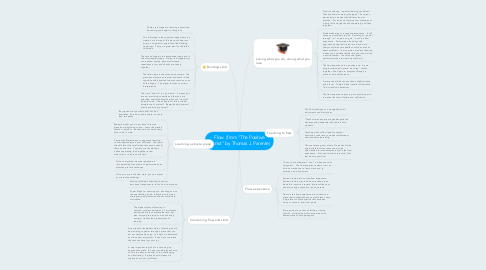Flow (from "The Positive Pianist" by Thomas J. Parente)
by Jesse Dunn

1. Building skills
1.1. There are 3 stages to learning a piece and becoming and expert in that piece
1.2. The first stage is the cognitive stage where we create a mind map of the piece, make gross errors, and perform operations like deciding fingerings. There is a great deal of self talk in this stage
1.3. The second stage is the associative stage and is the most lengthy stage. During this stage errors are reduced, tempo becomes increase, , repetitions occur, and chunks are strung together
1.4. The third stage is the autonomous stage. The piece has become automatic and there is little cognitive effort exerted towards conscious use of the fingers. The player focuses on artistic interpretation
1.5. The word "should" is a bad word. It means you are not practicing correctly and that you are attacking yourself based on what you "should" be able to do. The antidote for this is radical acceptance of yourself. Be gentle with yourself, praise and accept yourself
2. Combining flow and skills
2.1. Smart practicing is learning to use our emotional responses to tell us how to proceed
2.2. Power Steps for Learning are: knowing how to choose learning goals, reflecting on learning strategies, being conscious about sustaining motivation
2.3. The highest state of learning is success+volition+enjoyment. For instance, having the will to complete the task, but also enjoying the task, as well as having success, creates the highest state of learning
2.4. A contrast to the highest state of learning would be deciding to power through a piece that you do not necessarily enjoy. You become frustrated and lose your enjoyment. Even if you complete the task you have lost your joy
2.5. A very important topic here is choosing an appropriate piece. An appropriate piece should not be too easy or boring, or too challenging and frustrating. A piece should always be slightly above your skill level
3. Learning a simple piece
3.1. Be cognizant of your emotions such as frustration, boredom, and anxiety, as not to lead to apathy
3.2. Remember that you do not have to learn a piece from beginning to end. Learn the piece in chunks or sections. Sections do not necessarily have to be in order
3.3. There are different ways to approach learning chunks depending on your skill level. The lower the skill level, the smaller the chunks you should learn at one time. Typically you should learn hands separately, then together, a few measures, or a phrase at a time
3.4. Once completed, massive repetition is recognized by many famous performers as an effective practice technique
3.5. Once you are in the flow state, you can adjust your practice technique
4. Loving what you do, doing what you love
4.1. Flow is achieving "optimal learning conditions." These conditions are psychological. For piano particularly, a student should learn how to practice. For instance, learning four measures at a time, left and right hands separately, and then together.
4.2. Student shaming is a negative experience. It will cause your students to quit. Deciding to "power through" or "no pain no gain" is not the flow experience. Performers who adopt this approach during their career are much more likely to suffer severe health conditions such as heart problems. In my opinion, student shaming makes you a terrible teacher (maybe I should say a novice teacher. I know several great performers who are mediocre teachers)
4.3. The flow experience is a positive one. As we progress through a piece, we string "chunks' together. We begin to progress through a piece at a moderate pace.
4.4. A piece should be chosen that is slightly above one's level. To high a level results in frustration. To low results in boredom.
4.5. The flow experience puts joy into practicing and removes the fear of failure and self doubt.
5. Flow experience
5.1. "A sense of exhilaration" and " a deep sense of enjoyment" The flow experience stems from an intrinsic motivation to learn music and to practice one's instrument
5.2. Extrinsic factors are not the flow experience. Extrinsic factors may include to receive praise, be paid or receive a reward, impress friends or people, satisfy a teacher or one's parents
5.3. Goals in the flow experience are to choose a piece that is slightly above your skill level, have a high level of concentration that excludes worry or concern, and clear goals
5.4. More goals are no fear of failure or losing control, diminishing self-consciousness, an altered state of time perception
6. Teaching to flow
6.1. The flow technique can be applied to all instruments and disciplines
6.2. "Teachers who experience peak experience while teaching engender the same in their students"
6.3. Teaching without flow leads to teacher frustration, reduction in student self-esteem, and student vulnerability
6.4. Choose lesson goals wisely. Goals should be appropriate but also leave room to be open-ended for students who excel in the flow experience. Also, teach how to practice! Not just what to practice!


